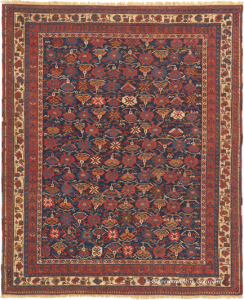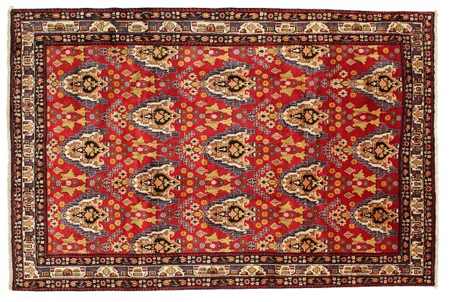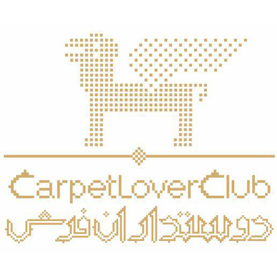afshar handmade carpet history
 Afshar
Afshar
4ft 2in x 5ft 2in
Circa 1850
The rugs of the Afshar tribes constitute one of the most interesting and ingratiating types of all Persian rustic weaving. The story is complex, and a bit of historical and ethnographic background is useful. The Afshar tribal group is located near Kerman city in Kerman Province in SE Persia. Originally, they were part of the Central Asian Turkmen Ghuz or Group of Turkic Tribes. By the later 15th century this section had split off and migrated to Azerbaijan in NW Persia. As nomadic tribes tend to be seen by complex social systems, they were often turbulent and undisciplined, and so most of them were forcibly relocated by Shah Tahmasp in the 16th century as far from Azerbaijan as possible. A few Afshars still reside in the northwest, but their rugs are quantitatively insignificant and do not resemble their southeast Persian relatives. The Kerman area tribal Afshars consist of two groups: the Afshars proper, south of Kerman town and the Buchakchis to the west. The Buchakchis must have split off from the main Afshar group before the nineteenth century. The Sirjan and Rafsanjani Afshars are Buchakchis. So are the Niriz Afshars. The rugs of the various tribal groupings are closely related, and they are all considered Afshars. The nomadic Turkic tribal folks have long intermarried with the settled Persian farmers and, again, all their rugs are considered Afshars. The Afshar tribal people speak both Turkish and Farsi. The nomadic Afshars seasonally migrate from cooler summer mountain pastures to warmer winter lowlands.
 Afshar
Afshar
4ft 1in x 5ft 0in
3rd Quarter, 19th Century
pattern, knot, design and colors of the afshar handmade carpet
 As befitting their tribal origins, the weavers, all women, work on frameless flat (horizontal) floor looms , whether in migration tents or in village houses. Virtually all rugs are in scatter sizes, although there are a few antique Afshars about ten feet by twenty feet which must have been woven on commission for the houses of the local gentry as they are much too large for use in the tribal black tents. There is also a sizeable production of saddlebags, both square and oblong, and rare bedding or cargo bags, long and boxlike with pile sides, ends and tops, and plain weave bottoms. Any antique Afshar nomadic bag is at least potentially collectible. The nomadic Afshar weavers can draw on their own flocks for supplies of excellent carpet wool and the villagers are scarcely less advantaged. As a result, the pile wool is of top quality. The dyes of antique Afshars are all natural, with the indigo blues dyed by the local village dye master and the weavers handling the rest. Madder, walnut husks, pomegranate rind, straw, and weld are among the other important dyestuffs. Synthetics are not used in antique rugs from Afshar. The structures of Afshars are all over the map. Originally, they were all wool in pile and foundation, but cotton warps and wefts became prevalent in the early 20th century. Or they are mixed. The knot is symmetric, except when it isn’t, which is much of the time. Warps are flat, but they can be semi-depressed, giving a firmer, less flexible fabric. Piles are generally medium-low, and the knot count runs between 60 and 150 per square inch. The women work quickly, and a scatter rug can be done in a month. Afshars are by far the most eclectic Persian tribal rugs in their designs. The powerful influence of nearby Kerman cannot be avoided, and many Afshars have been inspired by Kermans. Ivory grounds with dense millefleurs and cypress designs or informal renderings of vase layouts clearly derive from Kerman archetypes. Afshar weavers borrow from anywhere: a simplified version of the turtle border in horizontal rows in one field pattern; a repeat of European-style floral bouquets; Sarouk-Feraghan style octofoil and cartouche borders on Deh Shotoran village rugs; innumerable boteh patterns adopted from shawls, Fars Khamseh Baharlu rugs or Kerman city carpets; chickens taken from household fowl; copies of Turkman gul rugs or Baluchis. The weavers will even take over a rug pattern wholesale as in their interpretations of Fars tribal rugs. The weavers are working to sell and anything that sells is fodder for their imaginations. Whether there is any authentic Afshar design under all this is open to question. But the rugs are artistically viable in their own right. The weavers do mix things up: their Turkmen versions have deep blue grounds rather than the reds of the originals. The weavers’ patterns are mental and never drawn out: no cartoons, no samplers, no physical design reservoirs. A rug seen briefly in the bazaar may be an inspiration months later. Often the end finishes of Afshar rugs have broad bands in Soumak weft wrapping. This flat-weave technique is used on the rare and very collectible antique Afshar all Soumak rugs. The patterns are similar to those of pile rugs.
As befitting their tribal origins, the weavers, all women, work on frameless flat (horizontal) floor looms , whether in migration tents or in village houses. Virtually all rugs are in scatter sizes, although there are a few antique Afshars about ten feet by twenty feet which must have been woven on commission for the houses of the local gentry as they are much too large for use in the tribal black tents. There is also a sizeable production of saddlebags, both square and oblong, and rare bedding or cargo bags, long and boxlike with pile sides, ends and tops, and plain weave bottoms. Any antique Afshar nomadic bag is at least potentially collectible. The nomadic Afshar weavers can draw on their own flocks for supplies of excellent carpet wool and the villagers are scarcely less advantaged. As a result, the pile wool is of top quality. The dyes of antique Afshars are all natural, with the indigo blues dyed by the local village dye master and the weavers handling the rest. Madder, walnut husks, pomegranate rind, straw, and weld are among the other important dyestuffs. Synthetics are not used in antique rugs from Afshar. The structures of Afshars are all over the map. Originally, they were all wool in pile and foundation, but cotton warps and wefts became prevalent in the early 20th century. Or they are mixed. The knot is symmetric, except when it isn’t, which is much of the time. Warps are flat, but they can be semi-depressed, giving a firmer, less flexible fabric. Piles are generally medium-low, and the knot count runs between 60 and 150 per square inch. The women work quickly, and a scatter rug can be done in a month. Afshars are by far the most eclectic Persian tribal rugs in their designs. The powerful influence of nearby Kerman cannot be avoided, and many Afshars have been inspired by Kermans. Ivory grounds with dense millefleurs and cypress designs or informal renderings of vase layouts clearly derive from Kerman archetypes. Afshar weavers borrow from anywhere: a simplified version of the turtle border in horizontal rows in one field pattern; a repeat of European-style floral bouquets; Sarouk-Feraghan style octofoil and cartouche borders on Deh Shotoran village rugs; innumerable boteh patterns adopted from shawls, Fars Khamseh Baharlu rugs or Kerman city carpets; chickens taken from household fowl; copies of Turkman gul rugs or Baluchis. The weavers will even take over a rug pattern wholesale as in their interpretations of Fars tribal rugs. The weavers are working to sell and anything that sells is fodder for their imaginations. Whether there is any authentic Afshar design under all this is open to question. But the rugs are artistically viable in their own right. The weavers do mix things up: their Turkmen versions have deep blue grounds rather than the reds of the originals. The weavers’ patterns are mental and never drawn out: no cartoons, no samplers, no physical design reservoirs. A rug seen briefly in the bazaar may be an inspiration months later. Often the end finishes of Afshar rugs have broad bands in Soumak weft wrapping. This flat-weave technique is used on the rare and very collectible antique Afshar all Soumak rugs. The patterns are similar to those of pile rugs.


 Afshar
Afshar Afshar
Afshar As befitting their tribal origins, the weavers, all women, work on frameless flat (horizontal) floor looms , whether in migration tents or in village houses. Virtually all rugs are in scatter sizes, although there are a few antique Afshars about ten feet by twenty feet which must have been woven on commission for the houses of the local gentry as they are much too large for use in the tribal black tents. There is also a sizeable production of saddlebags, both square and oblong, and rare bedding or cargo bags, long and boxlike with pile sides, ends and tops, and plain weave bottoms. Any antique Afshar nomadic bag is at least potentially collectible. The nomadic Afshar weavers can draw on their own flocks for supplies of excellent carpet wool and the villagers are scarcely less advantaged. As a result, the pile wool is of top quality. The dyes of antique Afshars are all natural, with the indigo blues dyed by the local village dye master and the weavers handling the rest. Madder, walnut husks, pomegranate rind, straw, and weld are among the other important dyestuffs. Synthetics are not used in antique rugs from Afshar. The structures of Afshars are all over the map. Originally, they were all wool in pile and foundation, but cotton warps and wefts became prevalent in the early 20th century. Or they are mixed. The knot is symmetric, except when it isn’t, which is much of the time. Warps are flat, but they can be semi-depressed, giving a firmer, less flexible fabric. Piles are generally medium-low, and the knot count runs between 60 and 150 per square inch. The women work quickly, and a scatter rug can be done in a month. Afshars are by far the most eclectic Persian tribal rugs in their designs. The powerful influence of nearby Kerman cannot be avoided, and many Afshars have been inspired by Kermans. Ivory grounds with dense millefleurs and cypress designs or informal renderings of vase layouts clearly derive from Kerman archetypes. Afshar weavers borrow from anywhere: a simplified version of the turtle border in horizontal rows in one field pattern; a repeat of European-style floral bouquets; Sarouk-Feraghan style octofoil and cartouche borders on Deh Shotoran village rugs; innumerable boteh patterns adopted from shawls, Fars Khamseh Baharlu rugs or Kerman city carpets; chickens taken from household fowl; copies of Turkman gul rugs or Baluchis. The weavers will even take over a rug pattern wholesale as in their interpretations of Fars tribal rugs. The weavers are working to sell and anything that sells is fodder for their imaginations. Whether there is any authentic Afshar design under all this is open to question. But the rugs are artistically viable in their own right. The weavers do mix things up: their Turkmen versions have deep blue grounds rather than the reds of the originals. The weavers’ patterns are mental and never drawn out: no cartoons, no samplers, no physical design reservoirs. A rug seen briefly in the bazaar may be an inspiration months later. Often the end finishes of Afshar rugs have broad bands in Soumak weft wrapping. This flat-weave technique is used on the rare and very collectible antique Afshar all Soumak rugs. The patterns are similar to those of pile rugs.
As befitting their tribal origins, the weavers, all women, work on frameless flat (horizontal) floor looms , whether in migration tents or in village houses. Virtually all rugs are in scatter sizes, although there are a few antique Afshars about ten feet by twenty feet which must have been woven on commission for the houses of the local gentry as they are much too large for use in the tribal black tents. There is also a sizeable production of saddlebags, both square and oblong, and rare bedding or cargo bags, long and boxlike with pile sides, ends and tops, and plain weave bottoms. Any antique Afshar nomadic bag is at least potentially collectible. The nomadic Afshar weavers can draw on their own flocks for supplies of excellent carpet wool and the villagers are scarcely less advantaged. As a result, the pile wool is of top quality. The dyes of antique Afshars are all natural, with the indigo blues dyed by the local village dye master and the weavers handling the rest. Madder, walnut husks, pomegranate rind, straw, and weld are among the other important dyestuffs. Synthetics are not used in antique rugs from Afshar. The structures of Afshars are all over the map. Originally, they were all wool in pile and foundation, but cotton warps and wefts became prevalent in the early 20th century. Or they are mixed. The knot is symmetric, except when it isn’t, which is much of the time. Warps are flat, but they can be semi-depressed, giving a firmer, less flexible fabric. Piles are generally medium-low, and the knot count runs between 60 and 150 per square inch. The women work quickly, and a scatter rug can be done in a month. Afshars are by far the most eclectic Persian tribal rugs in their designs. The powerful influence of nearby Kerman cannot be avoided, and many Afshars have been inspired by Kermans. Ivory grounds with dense millefleurs and cypress designs or informal renderings of vase layouts clearly derive from Kerman archetypes. Afshar weavers borrow from anywhere: a simplified version of the turtle border in horizontal rows in one field pattern; a repeat of European-style floral bouquets; Sarouk-Feraghan style octofoil and cartouche borders on Deh Shotoran village rugs; innumerable boteh patterns adopted from shawls, Fars Khamseh Baharlu rugs or Kerman city carpets; chickens taken from household fowl; copies of Turkman gul rugs or Baluchis. The weavers will even take over a rug pattern wholesale as in their interpretations of Fars tribal rugs. The weavers are working to sell and anything that sells is fodder for their imaginations. Whether there is any authentic Afshar design under all this is open to question. But the rugs are artistically viable in their own right. The weavers do mix things up: their Turkmen versions have deep blue grounds rather than the reds of the originals. The weavers’ patterns are mental and never drawn out: no cartoons, no samplers, no physical design reservoirs. A rug seen briefly in the bazaar may be an inspiration months later. Often the end finishes of Afshar rugs have broad bands in Soumak weft wrapping. This flat-weave technique is used on the rare and very collectible antique Afshar all Soumak rugs. The patterns are similar to those of pile rugs.